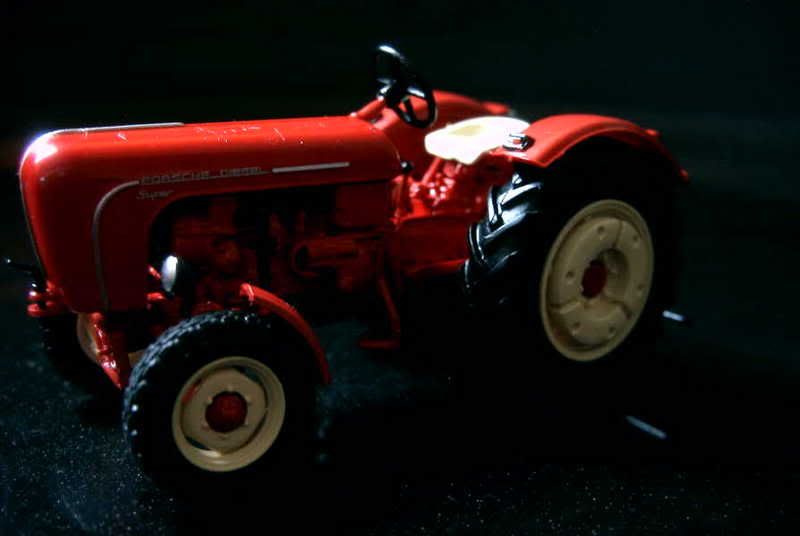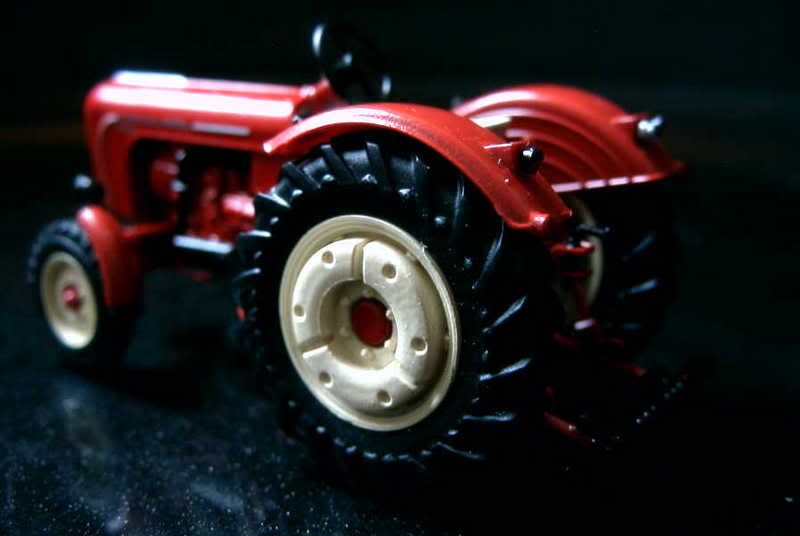A little history
Ferdinand Porsche wasn’t only busy designing what would become the Volkswagen during the Thirties – on his desk were also the blueprints of a Volk-Schlepper, the “People’s Tractor” that would motorized the German countryside. As with the popular car, with which the tractor shared many features, the farm-aimed Porsche didn’t entered production before the end of World War Two, though prototypes had been built as early as in 1934.
After the fall of the Third Reich, Ferdinand Porsche perfected his prototypes. All of his models were powered by diesel engines, a logical choice for a tractor. All were advanced designs, and included a four-wheel-drive version that was tested in 1946, though it eventually never reached production. Actually all other models could have never gone beyond prototype stage: an Allied edict stipulated that tractor production in postwar Germany would be limited to companies already active in this field before or during the war – this naturally excluded Porsche. Nonetheless these projects were so brilliant that they soon found an established company willing to build them under license: Allgaier GmbH, which undertook the construction of the twin-cylinder AP17 in 1950. A second manufacturer, Hofherr Schrantz, bought the rights for the Austrian market and simultaneously started production.
Allgaier produced one- and two-cylinder Porsche tractors with success until 1956, when the company was taken over by Mannesmann, a large Düsseldorf conglomerate willing to diversify its activities, and able to provide the large industrial facilities Allgaier lacked to fulfill the huge demand. And yes, this is the same company as the D2 Mannesmann – a cellphone operator – that faithfully appeared as a sponsor on many Mercedes-Benz racing cars during the Nineties.
Back to our story. Mannesmann created a dedicated division to handle the production of its tractors: Porsche-Diesel Motorenbau GmbH. Carmaker Porsche designed four models for Mannesmann to build: the Junior (1 cylinder, 0.8 litre, 14 hp), the Standard (2 cylinders, 1.4 litre, 25 hp), the Super (3 cylinders, 2.6 litres, 38 hp) and the Master (4 cylinders, 3.3 litres, 50 hp). Among those, the Super and, to some extent, the tiny Junior proved the most popular with farmers. Production of the all-red machines peaked at about 20,000 copies (a large share being exported) by 1958, but Mannesmann nevertheless soon lost its interest in its new venture. In 1962, the company announced that its tractors’ production would be suspended sometime in the near future. Its Konstanz Lake plant stopped building Porsche-Diesel machines in late 1963, though more tractors were built in the open, from spare parts on hands, for a few more months. By early 1964 though, the very last agricultural appliance to ever bear Porsche’s name had left the factory.
About the model
Model: Porsche-Diesel Super AP133
Year: 1958
Maker: Universal Hobbies
Scale: 1/43
Distributed by: Hachette as no.16 of its Tracteurs et Monde Agricole press series
Acquired: brand new, in December 2006, in Souillac, France
Yes, there was a diesel Porsche before the Cayenne. I really enjoy the contrast between this tractor with better-known Porsche road cars when I put them side-by-side on my shelves. Besides, it has been very nicely crafted by Universal Hobbies. My rating is 14/20.



Ferdinand Porsche wasn’t only busy designing what would become the Volkswagen during the Thirties – on his desk were also the blueprints of a Volk-Schlepper, the “People’s Tractor” that would motorized the German countryside. As with the popular car, with which the tractor shared many features, the farm-aimed Porsche didn’t entered production before the end of World War Two, though prototypes had been built as early as in 1934.
After the fall of the Third Reich, Ferdinand Porsche perfected his prototypes. All of his models were powered by diesel engines, a logical choice for a tractor. All were advanced designs, and included a four-wheel-drive version that was tested in 1946, though it eventually never reached production. Actually all other models could have never gone beyond prototype stage: an Allied edict stipulated that tractor production in postwar Germany would be limited to companies already active in this field before or during the war – this naturally excluded Porsche. Nonetheless these projects were so brilliant that they soon found an established company willing to build them under license: Allgaier GmbH, which undertook the construction of the twin-cylinder AP17 in 1950. A second manufacturer, Hofherr Schrantz, bought the rights for the Austrian market and simultaneously started production.
Allgaier produced one- and two-cylinder Porsche tractors with success until 1956, when the company was taken over by Mannesmann, a large Düsseldorf conglomerate willing to diversify its activities, and able to provide the large industrial facilities Allgaier lacked to fulfill the huge demand. And yes, this is the same company as the D2 Mannesmann – a cellphone operator – that faithfully appeared as a sponsor on many Mercedes-Benz racing cars during the Nineties.
Back to our story. Mannesmann created a dedicated division to handle the production of its tractors: Porsche-Diesel Motorenbau GmbH. Carmaker Porsche designed four models for Mannesmann to build: the Junior (1 cylinder, 0.8 litre, 14 hp), the Standard (2 cylinders, 1.4 litre, 25 hp), the Super (3 cylinders, 2.6 litres, 38 hp) and the Master (4 cylinders, 3.3 litres, 50 hp). Among those, the Super and, to some extent, the tiny Junior proved the most popular with farmers. Production of the all-red machines peaked at about 20,000 copies (a large share being exported) by 1958, but Mannesmann nevertheless soon lost its interest in its new venture. In 1962, the company announced that its tractors’ production would be suspended sometime in the near future. Its Konstanz Lake plant stopped building Porsche-Diesel machines in late 1963, though more tractors were built in the open, from spare parts on hands, for a few more months. By early 1964 though, the very last agricultural appliance to ever bear Porsche’s name had left the factory.
About the model
Model: Porsche-Diesel Super AP133
Year: 1958
Maker: Universal Hobbies
Scale: 1/43
Distributed by: Hachette as no.16 of its Tracteurs et Monde Agricole press series
Acquired: brand new, in December 2006, in Souillac, France
Yes, there was a diesel Porsche before the Cayenne. I really enjoy the contrast between this tractor with better-known Porsche road cars when I put them side-by-side on my shelves. Besides, it has been very nicely crafted by Universal Hobbies. My rating is 14/20.






2 comments:
nice shots with the cars!!! :-)
love that tractor! :-)
Thanks JD. I had the same comment about this picture years back on dcph. It was coming from Andy and, as he's one of the best model cars photographer I know, the compliment went straight to my heart. Actually I regret that the shot is not better centered, but that should be easy to fix.
Post a Comment